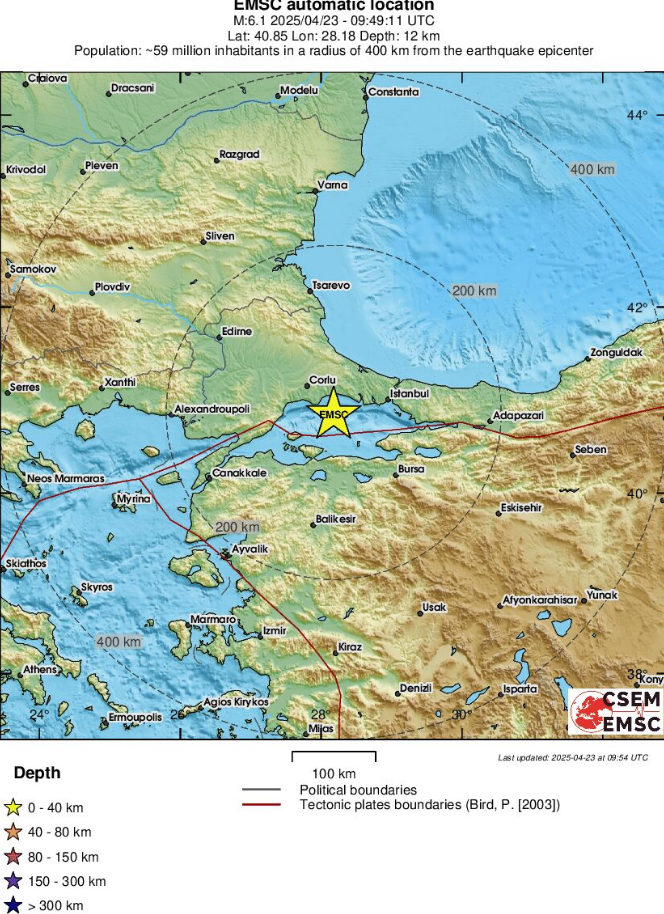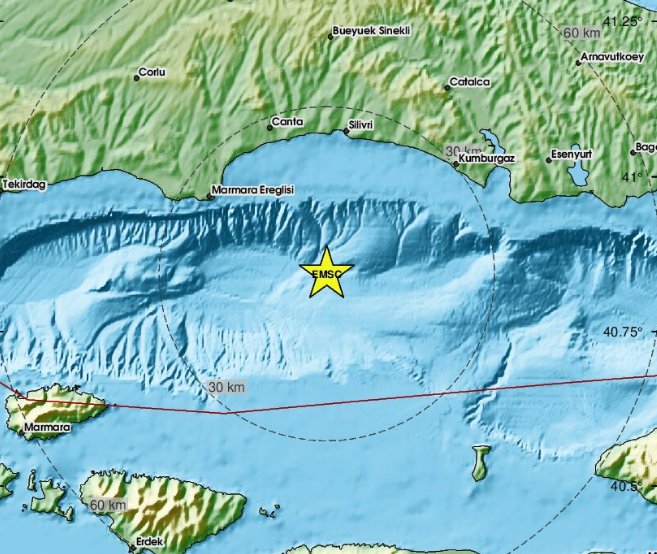The earthquake was particularly noticeable in the area as well as in parts of Greece – a man was injured after jumping from a balcony at the time of the earthquake
A strong 6.2 -magnitude earthquake rocked Constantinople early in the afternoon, one of the strongest vibrations that have shocked the Turkish metropolis in recent years, causing panic to residents and awakening memories and fears.
By 14:00 noon Turkey and Greece there are no records of material damage or victims, according to Turkish authorities.
The epicenter of the earthquake, which occurred at 12:49 was off the coast of Silibri, at the Marmara Sea, about 80 kilometers west of Constantinople, announced the Turkish Disaster and Emergency Disaster and Emergency (AFAD) and Minister of Interior.
The focal depth was 6.92 km, according to Afad. Similar was the measurement of the German Geosciences Research Center (GFZ), which said the earthquake was 6.2 degrees with a focal depth of 10 km except for the main earthquake, the Afad said it recorded three more vibrations of 3.9 to 4.9 degrees in the same area.
Thousands of people took panic -stricken streets, reporters from the French agency said. The TGRT television station reported that a man was injured after jumping from a balcony at the time of the earthquake.
In the center of the city, many people gathered in parks and others sat on the doorstep of their homes, as the aftershocks continued to become sensible. Some stores were closed after the earthquake that shaken the European side of the city.
It is about 30 – 40km west of Constantinople, on the coastline, a little in the sea, Professor Geology and OASP President Efthimios Lekkas told SKAI. He said he was in a difficult spot.
“It is within the expected earthquakes,” he said characteristically on SKAI’s 100.3 radio, noting that this earthquake may trigger some phenomena thereafter.
It is noted that the earthquake was felt in many areas of Thrace. Some residents both in the city of Komotini and in the wider Rodopi area, as well as in Xanthi, received a notice from the Google system of seismic vibration.
Many were surprised by the message as the focus of the seismic vibration is many kilometers from these areas. In fact, the message was appreciated by the magnitude of the earthquake and the possible damage to buildings and roads.
The message was also sent to the residents of Chios inviting them to be alert and noting that the aftershocks are common as shown in the picture below:
According to Turkish media reports, after a powerful earthquake of 6.2 on the Richter scale, an earthquake on the Richter scale was followed by an earthquake.
Watch videos from the moment of the strong 6.2 -on -earth -scale earthquake:
Investigations are ongoing – Erdogan is closely monitoring developments
President Recep Tayyip Erdogan said he was “closely monitoring developments” and Transport Minister Abdulkadir Veillou stressed that initial inspections did not show damage or problems on motorways, airports, railways.
“All emergency services are on alert. No building has collapsed, according to the information we have at this stage. We are continuing investigations, “the Constantinople Government said, calling on citizens to” stay away from damage buildings “. The municipality also stressed that it was monitoring the situation, stating that “no serious damage has been reported so far”.
At least two vibrations, with a fraction of a second fraction, became strongly felt in all districts of the city of 16 million inhabitants, as the country has an official holiday today.
Woke up memories of the 1999 murderous earthquake
Turkey is crossed by two faults that have caused many deadly earthquakes in the past.
The earthquake awakened memories of the 1999 deadly earthquake near Constantinople that killed 17,000 people.
Constantinople lives with the fear of a “grandeur” as it is 20 km from the northern Anatolian rift and some experts make forecasts for an earthquake at least 7 points by 2030, which would cause partial or total collapse of hundreds of thousands of buildings.
In February 2023, southeastern Turkey experienced the most devastating earthquake of its modern history, which killed at least 53,000 people, leveling cities, destroying historical monuments.
https://www.youtube.com/watch?v=nsjiwu5wz04
🇹🇷🫨terremoto de Magnitud 6.2 Sacudio en estambul
El epicentro se localizó en el de mármara.
La Ciudad se Sacudió notablemente, pero hasta el momento no habido informes de víctimas o Daños. pic.twitter.com/skhrkemn9p
– Pedro René González H (@peregonba) April 23, 2025
🇹🇷 | Urgente – Sismo de Magnitud 6.2 Sacude estambul con epicentro en el de mármara; La Ciudad Tembló Con Fuerza Pero Sin Reportes de Víctimas ni Daños Hasta Ahora. pic.twitter.com/yzikcxe9ky
– uhn plus (@uhn_plus) April 23, 2025
According to the same sources, an hour earlier, a 3.9 -magnitude earthquake was recorded in the area on the Richter scale, and around 12:13 noon at the Marmara Sea, near Constantinople. According to the AFAD (AFAD) treatment service, the focus of this earthquake was found in the maritime area 25.54 km south of Silivria, a suburb located west of Constantinople. The focal depth of the vibration was 6.99 km. The earthquake was felt in Silibria and in some areas west of Constantinople.
Difficult to know if it was the main earthquake, the Greek space is not affected, says Papazachos
Relatively limited is estimated to be the impact of the 6.2 magnitude Richter earthquake, which occurred today at noon west of Constantinople.
As the Professor of Physics of Lithosphere, Seismology and Applied Geophysics of AUTH Costas Papazachos told RES-EIA, the earthquake occurred in a “well-known Rhine area in the Northern Basin of Marmaras, which has historically given very strong earthquakes and” not very strong earthquakes “.
The difficulty, as the professor explained, lies in assessing whether this was the main earthquake. “The area hosts very large cracks, it is very difficult to predict how the seismic sequence will evolve”he said.
Mr Papazachos, however, clarified that such magnitude earthquakes are not capable of affecting faults in Greece, noting that the earthquake was felt in Thrace at low tensions.
Source :Skai
With a wealth of experience honed over 4+ years in journalism, I bring a seasoned voice to the world of news. Currently, I work as a freelance writer and editor, always seeking new opportunities to tell compelling stories in the field of world news.












